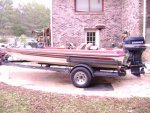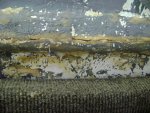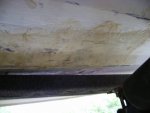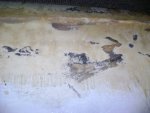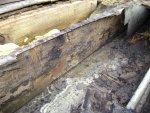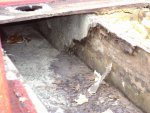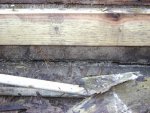Over30S130
Cadet
- Joined
- Oct 25, 2010
- Messages
- 21
I recently acquired an very early model Ranger 168V. PO informed me that the damage was repaired as a DIY backyard prooject. Not sure how the initial damage occurred or the extent. No holes, I think-just impact or stress cracks. He did atleast remove some of the sprayfaom on the interior of the hull and repair the inside with glass mat and resin and may have mentioned some extra wood bracing added as well. I have seen this yet as he appeared to have re-glassed that portion of the floor that was needed to gain access to the interior of the hull from the middle of the topside boatdeck by the steering console. He also said that he removed the motor and flipped it upside down for the bottom repair If Ok, I'm trying to get away with the simplest, but safe repair. The current visible issues are one or two 6" long cracks that will leak whenhull is subjected to water thru filling topside through transom/gas tank area. One crack on either side of center keel ridge. These cracks run parallel with ridge and are located at the base of each ridge where the flat part of the hull meets the base angle of the ridge. I can't remember the names of these and their purpose at the moment. Anyhow, on the other side of each ridge/crack, there is some visible repair running the length of the boat of say a 6" by 24" single mat layer with a thin coating of resin applied. Them resin here is discolored and some of the mat is peeling possibly due to age, poor application, or being subjected underwater speed conditions. The ridges themselves appear to have had some damage as they have more fiberglass mat layers and a little better repair job done. The current cracks/leaks appear to be just outside of any previous repair. PO did not divulge how the initial damage happened or either I missed that part, but said he did the best he knew how with resin and mat from both inside and out. Then on a subsequent outing when having it back on the water, he smacked an oncoming wake from a larger passing boat just right and later noticed his boat taking on water after getting to his favorite fishing hole and starting to fish. His pumps must not have been working properly or he would have noticed this sooner. It was confirmed when he decided to head back in and the rearward sloshing of water on takeoff came out of the deck drain hole at the foot of the driver/passenger seating. He assumed that he must have re-injured the repair job when earlier hitting the wake. He did not feel like doing it all over again, atleast right away and eventually just purchased another boat.
Could I safely use something like MarineTek to fill these cracks from the bottom and what to do about the flaking resin and mat in the other areas? would I just need to remove the loose material or all of this particular type of scanty repair and see what is underneath, as surely it will come off eventually as evident of what is seen so far and considering it will be subject underwater speed conditions as well again. With this part of the repair being somewhat transparrent, I don't see much damage underneath here, but not for sure. These areas may well be like putting an ACE bandage on a scratch, so-to-speak, and doesn't appear to be leaking here,yet. there are other areas on the bottomside that appear more well done and don't have that fiberglass mat/resin texture and have atleast been painted with some kind of white paint. This is my teenage son's boat and he is anxious to try it out, but we have all Winter to work on it if need be and safety comes first. Best scenario would be to make all repairs from the bottom hopefully without having to move boat on trailer or suspend above or remove trailer from underneath. Topside carpet will need to be repalced, but don't want to re-cut and repair floor yet again either. I have electric and air paoer tools and familiar with surface autobody repair. I definitely would not attempt Bondo for the repair, but am thinking that there might be some viable product solutions out there which would give a safe repair without having to re-open everything again.
Could I safely use something like MarineTek to fill these cracks from the bottom and what to do about the flaking resin and mat in the other areas? would I just need to remove the loose material or all of this particular type of scanty repair and see what is underneath, as surely it will come off eventually as evident of what is seen so far and considering it will be subject underwater speed conditions as well again. With this part of the repair being somewhat transparrent, I don't see much damage underneath here, but not for sure. These areas may well be like putting an ACE bandage on a scratch, so-to-speak, and doesn't appear to be leaking here,yet. there are other areas on the bottomside that appear more well done and don't have that fiberglass mat/resin texture and have atleast been painted with some kind of white paint. This is my teenage son's boat and he is anxious to try it out, but we have all Winter to work on it if need be and safety comes first. Best scenario would be to make all repairs from the bottom hopefully without having to move boat on trailer or suspend above or remove trailer from underneath. Topside carpet will need to be repalced, but don't want to re-cut and repair floor yet again either. I have electric and air paoer tools and familiar with surface autobody repair. I definitely would not attempt Bondo for the repair, but am thinking that there might be some viable product solutions out there which would give a safe repair without having to re-open everything again.




















